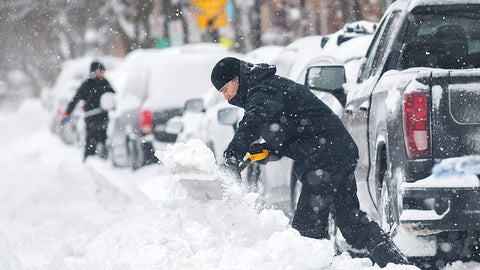Canada's vast expanse means that winter can vary significantly depending on where you are. From the mild wet winters on the west coast to the frigid cold in the Prairies, understanding the nuances of Canadian winter is the first step to effective preparation.
- Temperature Ranges: In Canada, winter temperatures can range from a mild 0°C on the west coast to a bone-chilling -40°C in the northern regions. It's essential to be aware of the average temperatures in your specific area to prepare adequately.
- East vs. West: While western Canada, especially coastal regions, experiences milder and wetter winters, eastern Canada often faces more severe cold, accompanied by significant snowfall. Central regions, particularly the Prairies, can experience very cold temperatures due to Arctic air masses.
- Wind Chill Factor: It's not just the actual temperature you need to be wary of. The wind chill factor can make conditions feel much colder than they are. For instance, a temperature of -20°C can feel like -30°C or colder with the wind chill. This perceived temperature is crucial when planning outdoor activities or dressing for the day.
Home Winterization

Ensuring your home is winter-ready is paramount for comfort and safety. A well-prepared home can also lead to significant energy savings.
- Indoor Heating and Humidity: As temperatures drop, indoor heating becomes essential. Regular maintenance of your heating system ensures it runs efficiently. Additionally, with heating often comes dry indoor air. Using humidifiers can help maintain optimal humidity levels, preventing issues like dry skin and respiratory discomfort.
- Sealing and Insulation: Drafts can be a major source of heat loss. Check for gaps around windows and doors and seal them using weatherstripping or caulk. Proper insulation, especially in attics and basements, is crucial to retain heat and reduce energy costs.
-
Optimizing Airflow with SmartCocoon: Traditional heating systems can sometimes lead to uneven heating, with some rooms feeling too hot and others too cold. The SmartCocoon booster fan is a game-changer in this aspect. By directing airflow effectively, it ensures even heating across all rooms, creating a comfortable environment throughout the home. An added advantage is the significant energy savings it offers. By optimizing airflow, SmartCocoon can help homeowners save up to 30% on their HVAC energy bills, making it not only a solution for comfort but also for cost-efficiency.

- Roof and Outdoor Areas: Snow and ice accumulation on roofs can lead to damage. Ensure your roof is in good condition, and gutters are clear of debris. Additionally, winterize outdoor areas like gardens by protecting plants and storing away summer equipment.
By taking these steps, you can ensure a warm and cozy home environment, ready to face the harshest of Canadian winters.
Car Winter-Readiness

Winter can be particularly harsh on vehicles. From freezing temperatures affecting battery life to icy roads reducing tire grip, it's essential to ensure your car is equipped to handle the challenges.
Winter Tires: These are not just a recommendation but a necessity in many parts of Canada. Winter tires provide better traction on snowy and icy roads, reducing the risk of accidents. Ensure they're in good condition and check the tire pressure regularly, as cold temperatures can cause it to drop.
- Fluids and Maintenance: Antifreeze levels should be checked and topped up if necessary. Switch to winter-grade windshield washer fluid which won't freeze on contact. Regularly inspect oil levels and consider using winter-grade oil for better engine performance in cold conditions.
- Battery Health: Cold temperatures can strain car batteries. It's advisable to have your battery tested before winter sets in and replace it if it's nearing the end of its lifespan.
- Emergency Car Kit: Canadian winters can be unpredictable. Equip your car with an emergency kit that includes essentials like jumper cables, a flashlight, blankets, a first-aid kit, non-perishable snacks, bottled water, a shovel, ice scraper, and snow brush.
Dressing for the Cold: A Layering Guide
Canadian winters demand a strategic approach to dressing. It's not just about wearing the thickest sweater you own but layering effectively to trap heat and stay comfortable.
The Science of Layering: Start with a moisture-wicking base layer to keep sweat away from the skin. Add an insulating layer, like a fleece or wool sweater, to trap heat. Finish with a waterproof and windproof outer layer to protect against snow and wind.
Material Matters: Wool and synthetic fibers are excellent for insulation, while cotton should be avoided as it retains moisture and can make you feel colder.
Accessorize Right: Don't underestimate the importance of gloves, hats, neck warmers, and thermal socks. A significant amount of body heat can be lost through the head, hands, and feet, so keeping them covered is crucial.
Footwear: Opt for waterproof and insulated boots. Ensure they have a good grip to prevent slips and falls on icy surfaces.
Embracing the Canadian Chill
By taking these steps, you can ensure a warm and cozy home environment, even during the most intense Canadian winters. Proper preparation enhances comfort, safety, and efficiency. For many, the Canadian winter brings unique experiences, scenic snow-covered landscapes, and the joy of winter activities. With the right preparations, every moment of this enchanting season can be cherished and enjoyed to the fullest.


